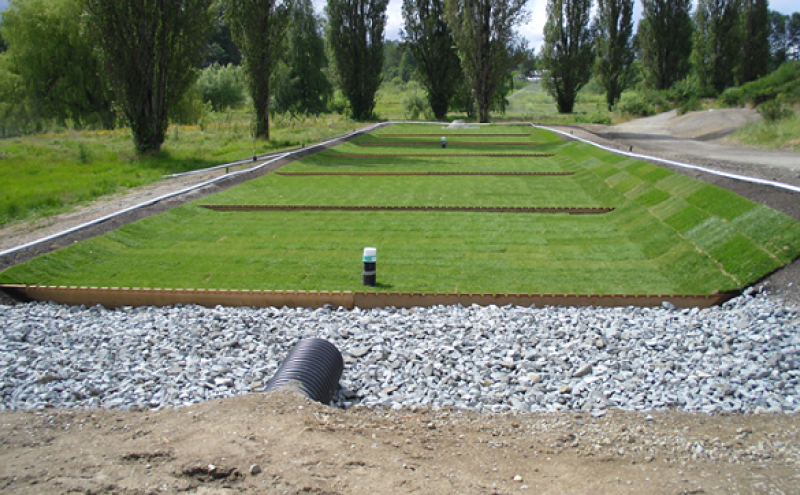
SEA Airport's Stormwater Program
Stormwater at Seattle-Tacoma International Airport
Clean water is a priority for businesses and citizens in Seattle and surrounding communities. The importance of water quality encompasses agriculture, commerce, tourism, recreation, and wildlife, all key drivers of the regional economy. Water quality is influenced by stormwater runoff and management. SEA Airport is responsible for 1,600 aces of drainage area that flows directly into three local streams and the Puget Sound.
Contamination of surface water can occur as a result of the storage, use, handling, and disposal of fuel and hazardous products on airport property. Because a substantial amount of the airport property is impervious, rain that falls onto runways, ramp areas, and buildings on the site runs off through drainage ditches and culverts and into the stormwater collection system. Aircraft fueling, equipment cleaning, oil and fuel spills, and maintenance activities are among the activities that can contaminate stormwater and runoff into surrounding streams if appropriate measures are not taken to prevent it. SEA’s network of stormwater collection piping, retention ponds, stormwater best management practices, and wastewater treatment facilities, effectively manage the risk to local waterways as demonstrated through the airport’s water quality monitoring program.
Stormwater runoff from the Airport drains to three local streams Miller Creek, Des Moines Creek and Gilliam Creek as well as directly to Puget Sound. In order to protect these aquatic resources, the airport has implemented numerous Best Management Practices (BMPs) to remove pollutants, reduce flooding and prevent spills from discharging into the environment.
Stormwater Management
Airport stormwater runoff is collected into two conveyance systems: Industrial Waste System (IWS) or Stormwater Drainage System (SDS) depending upon the activities that occur within each area. The IWS collects and treats stormwater from areas where aircraft or vehicle maintenance activities occur such as aircraft fueling and deicing. The SDS collects, detains and treats stormwater from the remaining portions of the airport including runways, expressways, the airport terminal and service road areas.
As part of the recently completed Master Plan improvements, the airport stormwater management systems have been completely retrofitted and upgraded to meet the most stringent environmental standards. Through these improvements runoff containing high concentrations of deicing fluids are captured and treated before being discharge to Puget Sound. Metals and other pollutants harmful to salmon and other aquatic organisms have been reduced to safe levels before entering local streams. Stormwater discharges from the airport are well below permit limits with low variability in comparison to other airports and industrial stormwater.
The airport evaluates and as needed implements new stormwater BMPs as part of its ongoing stormwater adaptive management program and Stormwater Pollution Prevention Plan (SWPPP) implementation. The adaptive management program takes a proactive approach and evaluates water quality monitoring results to determine if additional BMPs are necessary to prevent permit limit exceedances. If additional BMPs are needed, the program first evaluates if low impact development (LID) stormwater BMPs are feasible to meet permit limits followed by evaluation of traditional grey stormwater infrastructure. LID BMPs are evaluated on a project by project basis due to FAA restrictions related to compaction requirements and wildlife attractants, along with restrictions associated with industrial activities and structural limitations associated with infiltration within embankment areas.
The airport’s comprehensive Stormwater Pollution Prevention Plan includes a description of source control and treatment BMPs used at the airport.
Airport Stormwater Reports
Regular monitoring of all stormwater runoff generated at the airport is a critical component of our program. These testing requirements are the cornerstone of one of the most comprehensive National Pollution Discharge Elimination System (NPDES) permits issued by the Washington State Department of Ecology for an industrial facility. In addition to testing and reporting, the permit requires airport stormwater quality to meet stringent effluent limits established to protect aquatic resources in our local streams as well as Puget Sound.
The NPDES permit under which the airport operates requires the submittal of monthly and/or quarterly Discharge Monitoring Reports that compare stormwater runoff quality against effluent limitation concentrations, and annual reports that summarize each year’s monitoring results as well as improvements to our treatment programs.
Construction Stormwater Monitoring Reports
- 2023 Annual Construction Stormwater Monitoring Report
- 2022 Annual Construction Stormwater Monitoring Report
- 2021 Annual Construction Stormwater Monitoring Report
- 2019 Annual Construction Stormwater Monitoring Report
- 2018 Annual Construction Stormwater Monitoring Report
Industrial Stormwater Monitoring Reports
- 2023 Annual Industrial Stormwater Monitoring Report
- 2022 Annual Industrial Stormwater Monitoring Report
- 2021 Annual Industrial Stormwater Monitoring Report
- 2020 Annual Industrial Stormwater Monitoring Report
- 2019 Annual Industrial Stormwater Monitoring Report
- 2018 Annual Industrial Stormwater Monitoring Report
Industrial Waste System Stormwater Monitoring Reports
- 2023 Annual Industrial Waste System Stormwater Monitoring Report
- 2022 Annual Industrial Waste System Stormwater Monitoring Report
- 2021 Annual Industrial Waste System Stormwater Monitoring Report
- 2020 Annual Industrial Waste System Stormwater Monitoring Report
- 2019 Annual Industrial Waste System Stormwater Monitoring Report
- 2018 Annual Industrial Waste System Stormwater Monitoring Report

